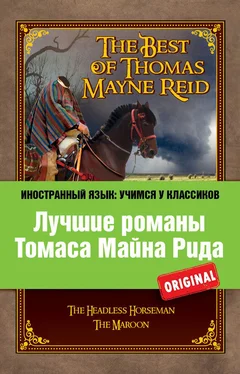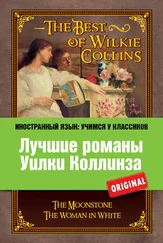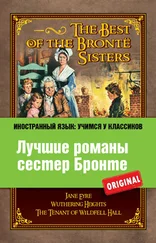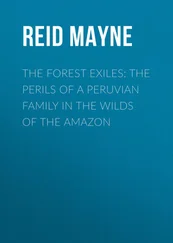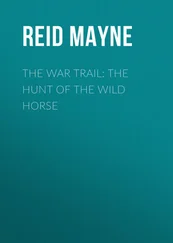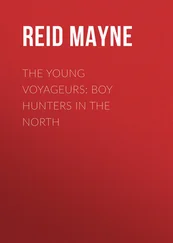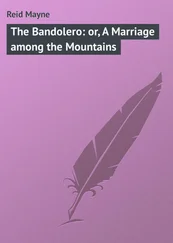Indeed, something more than superstitious terror might have hindered the execution of this last project: since a descent into the Duppy’s Hole appeared an impossibility. Down the beetling cliffs that encompassed it, there was neither path nor pass – not a ledge on which the foot might have rested with safety. Only at one point – and that where the precipice rose over the lagoon – might a descent have been made: by means of some stunted trees that, rooting in the clefts of the rock, formed a straggling screen up the face of the cliff. At this point an agile individual might possibly have scrambled down; but the dammed water – dark and deep – would have hindered him from reaching the quarter-deck of this ship-shaped ravine, unless by swimming; and this, the suck of the current towards the gorge below would have rendered a most perilous performance.
It was evident that some one had tempted this peril: for on scrutinising the straggling trees upon the cliff, a sort of stairway could be distinguished – the outstanding stems serving as steps, with the parasitical creepers connecting them together.
Moreover, at certain times, a tiny string of smoke might have been seen ascending out of the Duppy’s Hole; which, after curling diffusely over the tops of the tall trees, would dissolve itself, and become invisible. Only one standing upon the cliff above, and parting the foliage that screened it to its very brink, could have seen this smoke; and, if only superficially observed, it might easily have been mistaken for a stray waif of the fog that floated above the waterfall near which it rose. Closely scrutinised, however, its blue colour and soft filmy haze rendered it recognisable as the smoke of a wood fire, and one that must have been made by human hands.
Any day might it have been seen, and three times a-day – at morning, noon, and evening – as if the fire had been kindled for the purposes of cooking the three regular meals of breakfast, dinner, and supper.
The diurnal appearance of this smoke proved the presence of a human being within the Duppy’s Hole. One, at least, disregarding the superstitious terror attached to the place, had made it his home.
By exploring the valley, other evidences of human presence might have been found. Under the branches of a large tree, standing by the edge of the lagoon, and from which the silvery tillandsia [538]fell in festoons to the surface of the water, a small canoe of rude construction could be seen, a foot or two of its stem protruding from the moss. A piece of twisted withe, attaching it to the tree, told that it had not drifted there by accident, but was moored by some one who meant to return to it.
From the edge of the lagoon to the upper end of the valley, the ground, as already stated, was covered with a thick growth of forest timber – where the eye of the botanical observer might distinguish, by their forms and foliage, many of those magnificent indigenous trees for which the sylva [539]of Jamaica has long been celebrated.
There stood the gigantic cedrela, and its kindred the bastard cedar, with elm-like leaves; the mountain mahoe; the “tropic birch;” and the world-known mahogany.
Here and there, the lance-like culms of bamboos might be seen shooting up over the tops of the dicotyledons, or forming a fringe along the cliffs above, intermingled with trumpet-trees, with their singular peltate leaves, and tall tree-ferns, whose delicate lace-like fronds formed a netted tracery against the blue background of the sky. In the rich soil of the valley flourished luxuriantly the noble cabbage-palm – the prince of the Jamaica forest – while, by its side, claiming admiration for the massive grandeur of its form, stood the patriarch of West-Indian trees – the grand ceiba ; the hoary Spanish moss that drooped from its spreading branches forming an appropriate beard for this venerable giant.
Every tree had its parasites – not a single species, but in hundreds, and of as many grotesque shapes; some twining around the trunks and boughs like huge snakes or cables – some seated upon the limbs or in the forking of the branches; and others hanging suspended from the topmost twigs, like streamers from the rigging of a ship. Many of these, trailing from tree to tree, were loaded with clusters of the most brilliant flowers, thus uniting the forest into one continuous arbour.
Close under the cliff, and near where the cascade came tumbling down from the rocks, stood a tree that deserves particular mention. It was a ceiba of enormous dimensions, with a buttressed trunk, that covered a surface of more than fifty feet in diameter. Its vast bole, rising nearly to the brow of the cliff, extended horizontally over an area on which five hundred men could have conveniently encamped; while the profuse growth of Spanish moss clustering upon its branches, rather than its own sparse foliage, would have shaded them from the sun, completely shutting out the view overhead.
Not from any of these circumstances was the tree distinguished from others of its kind frequently met with in the mountain forests of Jamaica. What rendered it distinct from those around was, that between two of the great spurs extending outwards from its trunk, an object appeared which indicated the presence of man.
This object was a hut constructed in the most simple fashion – having for its side walls the plate-like buttresses already mentioned, while in front a stockade of bamboo stems completed the inclosure. In the centre of the stockade a narrow space had been left open for the entrance – which could be closed, when occasion required, by a door of split bamboos that hung lightly upon its hinges of withe.
In front, the roof trended downward from the main trunk of the tree – following the slope of the spurs to a height of some six feet from the ground. Its construction was of the simplest kind – being only a few poles laid transversely, and over these a thatch of the long pinnate leaves of the cabbage-palm.
The hut inside was of triangular shape, and of no inconsiderable size – since the converging spurs forming its side walls extended full twelve feet outwards from the tree. No doubt it was large enough for whoever occupied it; and the platform of bamboo canes, intended as a bedstead, from its narrowness showed that only one person was accustomed to pass the night under the shelter of its roof.
That this person was a man could be told by the presence of some articles of male attire lying upon this rude couch – where also lay a strip of coarse rush matting, and an old, tattered blanket – evidently the sole stock of bedding which the hut contained.
The furniture was scanty as simple. The cane platform already mentioned appeared to do duty also as a table and chair; and, with the exception of an old tin kettle, some calabash bowls and platters, nothing else could be seen that might be termed an “utensil.”
There were articles, however, of a different character, and plenty of them; but these were neither simple nor their uses easily understood.
Against the walls hung a variety of singular objects – some of them of ludicrous and some of horrid aspect. Among the latter could be observed the skin of the dreaded galliwasp; the two-headed snake; the skull and tusks of a savage boar; dried specimens of the ugly gecko lizard; enormous bats, with human-like faces; and other like hideous creatures.
Little bags, suspended from the rafters, contained articles of still more mysterious import. Balls of whitish-coloured clay; the claws of the great-eared owl; parrots’ beaks and feathers; the teeth of cats, alligators, and the native agouti; pieces of rag and broken glass; with a score of like odds and ends, forming a medley as miscellaneous as unintelligible.
In one corner was a wicker basket – the cutacoo – filled with roots and plants of several different species, among which might be identified the dangerous dumb-cane; the savanna flower; and other “simples” of a suspicious character.
Читать дальше
Конец ознакомительного отрывка
Купить книгу
